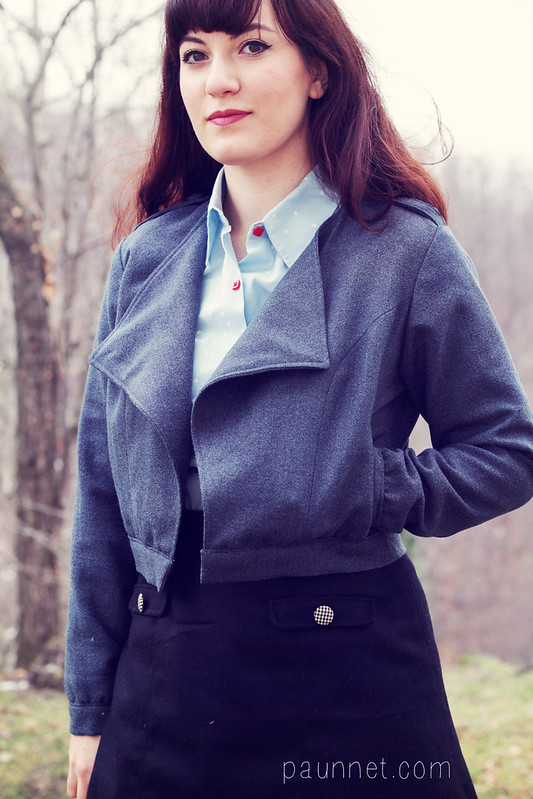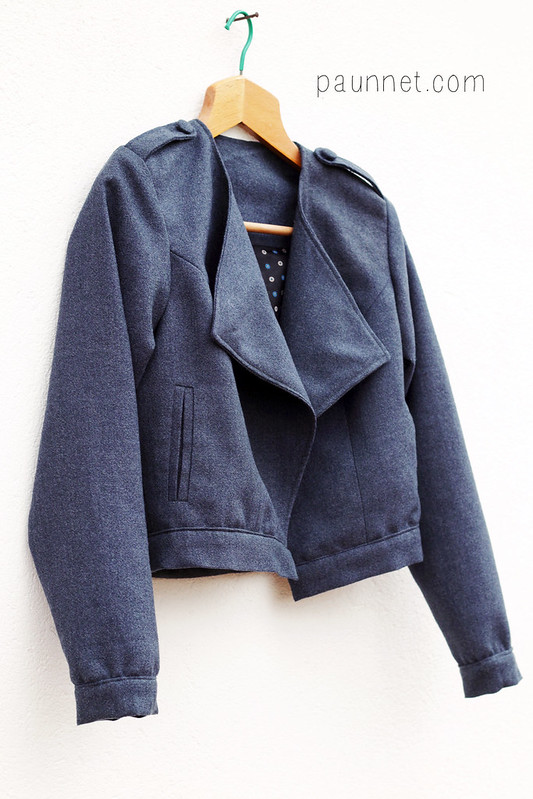Pattern: Katja shirt by Schnittchen
Size: 38
Alterations: none
Fabric: striped jersey viscose + lace trim c/o Supercut
Today I'm happy to present my project for Sewing Around The World, an idea of German indie pattern company Schnittchen involving 12 sewing blogger from different countries throughout 2016.
I'm following Silvia from Germany who sewed the Joanna coat and Julie from France, with the Lola cardigan.
My own pick was the Katja shirt, a knit kimono top with a relaxed fit, an optional triangular appliqué and two different length options (I used the shorter one). The pattern is available both as a PDF and as a printed pattern, at very affordable prices, and has instructions in either German or English.
So... Why did I choose this pattern?
To be completely honest, it was the result of compromise. I LOVED the patterns that the two previous bloggers chose, so they were not an option.
The other patterns I liked didn't have English instructions (such as the Nina pants) and I also wanted something easy and quick to sew, because I thought I would be knee deep in moving into my new home in March (which is not the case yet... don't ask).
I'm also always up for trying new silhouettes that are out of my comfort zone (meaning, basically anything that doesn't have a cinched waist).
Uuunnnh... Yes and no.
These are the things I like:
- The comfort: while I don't think this is particularly flattering on me, I can't deny it's really comfortable and snuggly. After taking these photos in the late afternoon, I didn't take it off until I changed in my PJs.
- The V: I think it makes the shirt unique and gives you the possibility to use many trims.
I chose lace, but Supercut also sent me some gold piping that would have looked pretty nice with it.
At the same time, it's an appliqué, so it will add weight to the shirt and it will make the neckline seam significantly more bulky.
If you don't like the V, it's optional, so you can forget about it. - The milted corners: Katja has little slits on the side seams and they are finished with milted corners, which are easy to sew but give a super nice finish.
 |
| This viscose is not the easiest to sew. I gave up matching stripes on the sides after unpicking a couple times, out of frustration. |
Now, for the things I don't like:
- The pattern: Multiple parts of the pattern do not match, specifically the front and back sides and the shoulder of the appliqué with the main shirt.
I am getting more and more picky with patterns ever since starting taking patternmaking classes, but things not matching up are really annoying, period, no matter how skillful you are.
Also, the neckline band is cut on the bias and that's unnecessary, unless you're using a knit with very little stretch.
EDIT: Silke, creator of Schnittchen patterns, explains:
"Concerning the bias tape: this pattern piece had to be constructed as bias tape because you can sew Katja also with cotton so to say with fabrics without ANY elastic. So we had to construct the neckline band as bias. This is also the reason for the quite wide neckline...Concerning the side seams: the length of the side seams fit perfectly, however we had to construct the curve in the front side seam different to that in the back because we left out the darts in the front pattern piece. So these (the darts or better to say the width of the darts) were "turned" to side seam. We needed to do this because in the front piece you have to have more width because of the busts.."
(More in the comment section) - The fit: this is JUST personal preference, but this shirt has a lot of ease and I just don't like it. It makes me look so much bigger than I am.
The neckline is too wide (again, for my taste), and the bottom is flared, which I don't think is too flattering on this length. - The instructions: the instructions that come with the pattern are VERY essential. You might not care in the least for this, but I do like my instructions to be clear and thorough, especially for beginners patterns. I guess this has to do with the affordable price of the pattern: more pages and illustrations = higher costs.
Schnittchen does offer a photo tutorial for Katja (which I could only find in German), and that's great, but that means you need a device and an Internet connection while you sew.
All in all, I enjoy my finished top but I think this pattern could use some improvements.
If you like a loose fit, and are looking for a comfy top pattern with unique details at a reasonable price, this might be the one for you!Thanks Schnittchen for including me in this beautiful tour, I'm really grateful :D
*** This post is sponsored by Schnittchen ***
Modello: maglia Katja di Schnittchen
Taglia: 38
Modifiche: nessuna
Tessuto: jersey di viscosa a righe + nastro in pizzo c/o Supercut
Oggi, sono lieta di presentarvi il mio progetto per Sewing Around The World, un'idea della compagnia indie tedesca di cartamodelli Schnittchen, a cui partecipano, cucendo modelli di questo designer, 12 blogger di cucito da tutto il mondo durante il 2016.
Io seguo Silvia dalla Germania che ha cucito il meraviglioso cappotto Joanna e Julie dalla Francia, con il cardigan Lola.
La mia scelta è ricaduta sul top Katja, una maglietta a kimono con vestibilità molto rilassata, un'applique triangolare opzionale e due diverse opzioni di lunghezza (io ho tagliato la più corta).
Il modello è disponibile sia come PDF che in versione stampata, a un prezzo piuttosto conveniente, e le istruzioni sono disponibili in tedesco o inglese.
Ma quindi... Perchè ho scelto questo modello?
Ad essere completamente sincera, è stato il risultato di un compromesso. Mi piacevano moltissimo i due modelli usati dalle ragazze prima di me (ma non potevo fare una ripetizione); gli altri modelli di mio gusto non avevano le istruzioni in inglese (tipo i pantaloni Nina) e inoltre volevo qualcosa di rapido da cucire, perchè al momento della scelta pensavo che a marzo sarei stata fino al collo in mezzo al trasloco (cosa che per vari motivi non è ancora successa, stendiamo un pietoso velo).
Infine, accetto sempre di buon grado nuove "sfide" per quanto riguarda le silhouette da indossare (nel mio caso, qualsiasi cosa non sia stretto in vita).
Eeeeeeehhh... Sì e no.
Queste sono le cose che mi piacciono:
- La comodità: anche se trovo che questo top non mi valorizzi particolarmente, non posso negare che è estremamente comodo e coccoloso. Dopo aver scattato queste foto nel tardo pomeriggio, non me lo sono tolto finché non sono andata a dormire, e l'ho scambiato col pigiama.
- La V: Trovo che renda il top unico e che ti dia la possibilità di usare un sacco di passamanerie. Io ho optato per il pizzo, ma Supercut mi aveva anche mandato del profilo dorato che sarebbe stato carinissimo.
Allo stesso tempo, ricordate che la V è un applique, e quindi aggiungerà peso al top e renderà la cucitura dello scollo più spessa.
Però, se a voi non piace, è assolutamente facoltativa. - Gli angoli squadrati (tipo tovaglia): Katja ha degli spacchetti nelle cuciture dei fianchi rifinite con angoli quadrati (per intenderci, quelli con la diagonale). Sono semplici da cucire e danno veramente una bella finitura.
E ora, le cose che non mi piacciono:
- Il modello: ho trovato più pezzi del modello che non combaciavano; i peggiori erano il fianco davanti e dietro, ma anche l'applique non combacia sulla spalla del pezzo davanti.
Mi rendo conto che da quando studio modellistica sono più esigente, ma si tratta di controlli basilare che una modellista dovrebbe fare sempre, e mi dà veramente fastidio trovare questo genere di errore in un modello commerciale.
Inoltre, la striscia per lo scollo viene fatta tagliare in sbieco, cosa completamente inutile a meno che il vostro tessuto sia veramente poco stretch. - La vestibilità: si tratta di gusto personale, ma questo top ha veramente tantissima vestibilità. Avrei tranquillamente potuto tagliare due taglie in meno e avere una maglia comunque comoda. Così larga proprio non mi piace, specialmente con questa svasatura piuttosto pronunciata sul fondo.
Sempre a proposito di gusto personale, non mi piace lo scollo, troppo largo per essere così alto. - Le istruzioni: le istruzioni incluse nel modello sono MOLTO stringate. Magari a voi non importa e preferite cucire senza nemmeno guardarle, ma a me piace che le istruzioni siano complete e dettagliate, specialmente se si tratta di un progetto per principianti (che hanno bisogno di essere guidati).
Immagino però che la questione sia legata al prezzo piuttosto basso del modello: più pagine e illustrazioni o foto = costo più elevato.
Schnittchen offre comunque un fototutorial per Katja (che però ho trovato solo in tedesco), ed è fatto molto bene, ma ciò significa che voi dobbiate avere a disposizione un dispositivo e una connessione internet mentre cucite.
Tutto sommato il risultato non mi dispiace (lo indosserò in situazioni di comfort), ma credo che il modello avrebbe bisogno di una messa a punto.
Se a voi piacciono i top loose e volete un modello per una maglia comoda e con dettagli particolari a un prezzo contenuto, magari Katja fa per voi!
Grazie ancora a Schnittchen per avermi incluso in questo tour del mondo!
*** Questo post è sponsorizzato da Schnittchen ***











